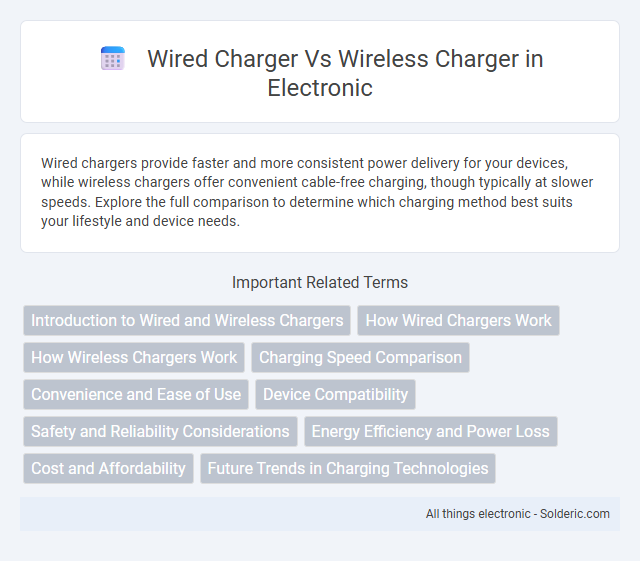Wired chargers provide faster and more consistent power delivery for your devices, while wireless chargers offer convenient cable-free charging, though typically at slower speeds. Explore the full comparison to determine which charging method best suits your lifestyle and device needs.
Comparison Table
| Feature | Wired Charger | Wireless Charger |
|---|---|---|
| Charging Speed | Faster, supports fast charging up to 100W+ | Slower, typically 5W-15W, depends on device |
| Convenience | Requires cable connection | Place device on pad, cable-free experience |
| Compatibility | Universal with correct cable | Needs Qi-compatible devices |
| Portability | Compact, dependent on cable | Bulkier base, no cables needed |
| Device Wear | Frequent plugging may cause port wear | No port wear, contactless charging |
| Cost | Generally lower-priced | Usually more expensive |
| Heat Generation | Less heat produced | Can generate more heat during charging |
Introduction to Wired and Wireless Chargers
Wired chargers deliver power through a physical cable connecting the device to a power source, offering faster charging speeds and reliable energy transfer. Wireless chargers utilize electromagnetic fields to transmit energy without cables, promoting convenience and reducing wear on device ports. Both technologies support various power standards, such as USB Power Delivery for wired and Qi protocol for wireless charging.
How Wired Chargers Work
Wired chargers transmit electrical current directly from a power source to a device through a cable, ensuring efficient and fast energy transfer. These chargers use USB standards, such as USB-C or Lightning, to deliver consistent voltage and current tailored to the device's specifications, supporting rapid charging and data synchronization. The direct connection minimizes energy loss, providing reliable power delivery compared to wireless alternatives.
How Wireless Chargers Work
Wireless chargers operate using electromagnetic induction to transfer energy between two coils: a transmitter coil in the charging pad and a receiver coil in the device. The charger generates an alternating electromagnetic field, which induces an electric current in the receiver coil, powering the device's battery without physical connectors. Qi wireless charging is the most widely adopted standard, ensuring compatibility across various smartphones and accessories.
Charging Speed Comparison
Wired chargers typically provide faster charging speeds due to direct power transfer, with many models delivering up to 100W or more, enabling devices to charge from 0% to 50% in under 30 minutes. Wireless chargers usually offer lower wattage, commonly ranging from 5W to 15W, resulting in slower charge times that can extend up to twice as long for the same battery capacity. Advances in fast wireless charging technology, such as Qualcomm Quick Charge or Apple's MagSafe, have improved speeds but still generally lag behind wired solutions in overall efficiency.
Convenience and Ease of Use
Wireless chargers offer unparalleled convenience by eliminating the need for cables, allowing You to simply place your device on a charging pad for effortless power replenishment. Wired chargers provide faster, more reliable charging speeds, making them ideal for rapid device charging but require physical connection. Your choice depends on prioritizing ease of use with wireless technology or speed with traditional wired connections.
Device Compatibility
Wired chargers offer broad device compatibility, supporting most smartphones, tablets, and laptops with standard USB connectors like USB-C and Lightning. Wireless chargers require devices to have Qi-compatible technology, which limits their use to newer models of phones and accessories. Some wireless chargers also support specific brands or power delivery standards, affecting the range of compatible devices.
Safety and Reliability Considerations
Wired chargers generally offer higher safety standards due to direct power transfer, reducing risks of overheating and electrical interference, which ensures stable and reliable charging performance. Wireless chargers can pose potential safety concerns such as excessive heat generation and electromagnetic radiation exposure if not properly certified or used with compatible devices. Choosing chargers with reputable certifications like UL, CE, or FCC significantly enhances safety and reliability whether using wired or wireless charging technology.
Energy Efficiency and Power Loss
Wired chargers typically offer higher energy efficiency with minimal power loss, often exceeding 85%, due to direct electrical connections that reduce resistance and heat generation. Wireless chargers experience increased energy loss from electromagnetic induction, with efficiency rates generally between 60% and 75%, leading to longer charging times and wasted power in the form of heat. Optimizing coil alignment and using advanced materials can marginally improve wireless charging efficiency but still lag behind wired solutions in power transfer effectiveness.
Cost and Affordability
Wired chargers generally offer greater affordability, with prices ranging from $10 to $30 for reliable models, making them cost-effective for daily use. Wireless chargers tend to be more expensive, typically starting around $25 and reaching upwards of $60 depending on brand and charging speed. Investing in wired chargers provides lower initial costs and faster charging efficiency, while wireless options may incur higher expenses but offer the convenience of cable-free power.
Future Trends in Charging Technologies
Future trends in charging technologies highlight increased adoption of wireless power transfer with improvements in efficiency, range, and integration into everyday surfaces like furniture and vehicles. Wired chargers will continue evolving with faster charging speeds, enhanced cable durability, and compatibility with emerging USB standards such as USB4 and Power Delivery 3.1. Hybrid systems combining wired and wireless charging functions are also expected, ensuring versatile and seamless power solutions for next-generation devices.
Wired charger vs Wireless charger Infographic

 solderic.com
solderic.com